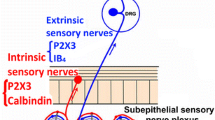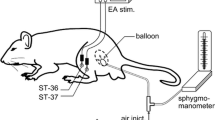Abstract
Objective
To compare the regulatory effects of electro-acupuncture (EA) at acupoints Zusanli (ST36) and Hegu (LI4) on the visceral hyper-sensitivity in the rat model of irritable bowel syndrome (IBS), and to explore the acting targets and specialty of acupoints.
Methods
Except 8 rats of the normal control group, the rest 32 rats were prepared to set up the IBS models. IBS animal model was prepared by enema with acetic acid. Model rats were divided into three groups. Except for rats in the model group for control, those in the other two groups were treated 20 min by EA on ST36 (EA-ST36) and LI4 (EA-LI4) respectively for 2 weeks to observe the effect on behavior response of viscera sensitivity. The changes of neuropeptide (NPY), the somatostatin (SS) levels in blood and tissues of brain and intestine were monitored as well.
Results
The volume thresholds for abdomen uplifting and back hunching were obviously increased after EA-ST36 (P<0.05), but showed insignificant change after EA-LI4. NPY contents lowered and SS contents increased in model rats; both EA-ST36 and EA-LI4 could raise the level of thalamic NPY (P<0.01 and P<0.05, respectively), but showed insignificant effects on NPY in colonic tissue. As for SS content, its colonic level could be reduced by EA-S36 and EA-LI4 (P<0.01 and P<0.05, respectively), however, its blood level was affected only by EA-ST36 (P<0.05).
Conclusions
EA-ST36 or EA-LI4 could regulate the NPY in thalamus and SS in colonic tissue, the former could affect blood level of SS as well. It is deemed that NPY and SS may be the key substances for regulating the action of acupuncture in the brain-intestinal axis; their different levels could be regarded as an indicator for the functional difference between the acupoints.
Similar content being viewed by others
References
Andresen V, Camilleri M. Irritable bowel syndrome: recent and novel therapeutic approaches. Drugs 2006;66:1073–1088.
O’Mahony SM, Hyland NP, Dinan TG, Cryan JF. Maternal separation as a model of brain-gut axis dysfunction. Psychopharmacology (Berl) 2011;214:71–88.
Sheehan J, Gaman A, Vangel M, Kuo B. Pooled analysis of brain activity in irritable bowel syndrome and controls during rectal balloon distension. Neurogastroenterol Motil 2011;23:336–9158. doi: 10.1111/j.1365-2982.2010.01635.x.
Elsenbruch S. Abdominal pain in irritable bowel syndrome: a review of putative psychological, neural and neuro-immune mechanisms. Brain Behav Immun 2011;25:386–394.
Ohman L, Simren M. Pathogenesis of IBS: role of inflammation, immunity and neuroimmune interactions. Nat Rev Gastroenterol Hepatol 2010;7:163–173.
Camilleri M, Tack JF. Current medical treatments of dyspepsia and irritable bowel syndrome. Gastroenterol Clin North Am 2010;39:481–493.
Pan F, Zhang T, Zhang YH, Xu JJ, Chen FM. Effect of Tongxie Yaofang (痛泻要方) granule in treating diarrhea-predominate irritable bowel syndrome. Chin J Integr Med 2009;15:216–219.
Tang ZP. Traditional Chinese medicine Clinical experience of the treatment for irritable bowel syndrome. Chin J Integr Med 2009;15:93–94.
Zhang SS. Thinking and strategy on the diagnosis and treatment of functional gastrointestinal disorders with integrative medicine. Chin J Integr Med 2009;15:83–85.
AL-Chaer ED, Kawasaki M, Pasricha PJ. A new model of chronic visceral hypersensitivity in adult rats induced by colon irritation during postnatal development. Gastroenterology 2000;119:1276–1285.
Liu YB, Yuan YZ, Tao RJ, Zhai ZK, Chen HZ. The establishment of bowel hign-sensitivity models and evaluation of visceral hypersensitivity in rats. Chin J Digestion (Chin) 2003;23:34–37.
Zhang LF, ed. Experimental acupuncturology. Beijing: Chemical Industry Press; 2010:219–221.
Mayer EA, Collins SM. Evolving pathophysiologic models of functional gastrointestinal disorders. Gastroenterology 2002;122:2032–2048.
Wang WA, Qian JM, Pan GZ, Wen SH, Zhang YP. The establishment of brain-bowel interactive orientability condition stress model in irritable bowel syndrome rat. Chin J Digestion (Chin) 2004;24:590–593.
Zhao JH, Dong L, Hao XQ. Small intestine motility and gastrointestinal hormone levels in irritable bowel syndrome. J Southern Med Univ (Chin) 2007;27:1492–1495.
Mayer EA, Tillsch K. The brain-gut axis in abdominal pain syndromes. Annu Rev Med 2011;62:381–396.
Bonaz B. Brain-gut interactions. Rev Med Interne 2010;31:581–585.
Bonaz B, Sabate JM. Brain-gut axis dysfunction. Gastroenterol Clin Biol 2009;33 (Suppl 1):S48–S58.
Mayer EA, Naliboff BD, Chang L, Coutinho SV. V. stress and irritable bowel syndrome. Am J Physiol Gastrointest Liver Physiol 2001;280:G519–G524.
O’Mahony SM, Marchesi JR, Scully P, Codling C, Ceolho AM, Quigley EM, et al. Early life stress alters behavior, immunity, and microbiota in rats: implications for irritable bowel syndrome and psychiatric illnesses. Biol Psychiatry 2009;65:263–267.
Sykes MA, Blanchard EB, Lackner J, Keefer L, Krasner S. Psychopathology in irritable bowel syndrome: support for a psychophysiological moedel. J Behav Med 2003; 26:361–372.
Solmaz M, Kavuk I, Sayar K. Psychological factors in the irritable bowel syndrome. Eur J Med Res 2003;8:549–556.
Smulevich AB, Rappoport Sl, Syrkin AL, Ovcharenko SI, Ivanov SV, Drobizhev MIu, et al. Visceral neuroses: clinical approaches to the problem. Zh Nevrol Psikhiatr Im S S Korsakova 2002;102:15–21.
Xu JY, Yan B, Wang FQ. Study on acupuncture at Hegu (LI4) on brain imaging. Chin J Rehabil Theory Pract (Chin) 2005;11:832–833.
Jin ZG, Jing XH, Zhang JL. Cai H, Lu B, et al. Effect of eleacupuncture at Hegu (LI4) and Sibai (ST2) on discharges of gastric neurons of nucleus tractus solitarii in the rat. Acupunct Res (Chin) 2006;31:46–49.
Husum H, Van Kammen D, Termeer E, Bolwig G, Mathe A. Topiramate normalizes hippocampal NPY-LI in flinders sensitive line "depressed" rats and upregulates NPY, galanin, and CRH-LI in the hypothalamus: implications for mood-stabilizing and weight loss-inducing effects. Neuropsychopharmacology 2003;28:1292–1299.
Binimelis J, Webb SM, Mones J. Somatostatin and irritable bowel syndrome. Lancet 1987;2:1533.
Author information
Authors and Affiliations
Corresponding author
Additional information
Supported by National Basic Research Program of China (973 Plan, No. 2005CB523308)
Rights and permissions
About this article
Cite this article
Zhu, Wl., Li, Y., Wei, Hf. et al. Effect of electro-acupuncture at different acupoints on neuropeptide and somatostatin in rat brain with irritable bowel syndrome. Chin. J. Integr. Med. 18, 288–292 (2012). https://doi.org/10.1007/s11655-011-0795-y
Received:
Published:
Issue Date:
DOI: https://doi.org/10.1007/s11655-011-0795-y




